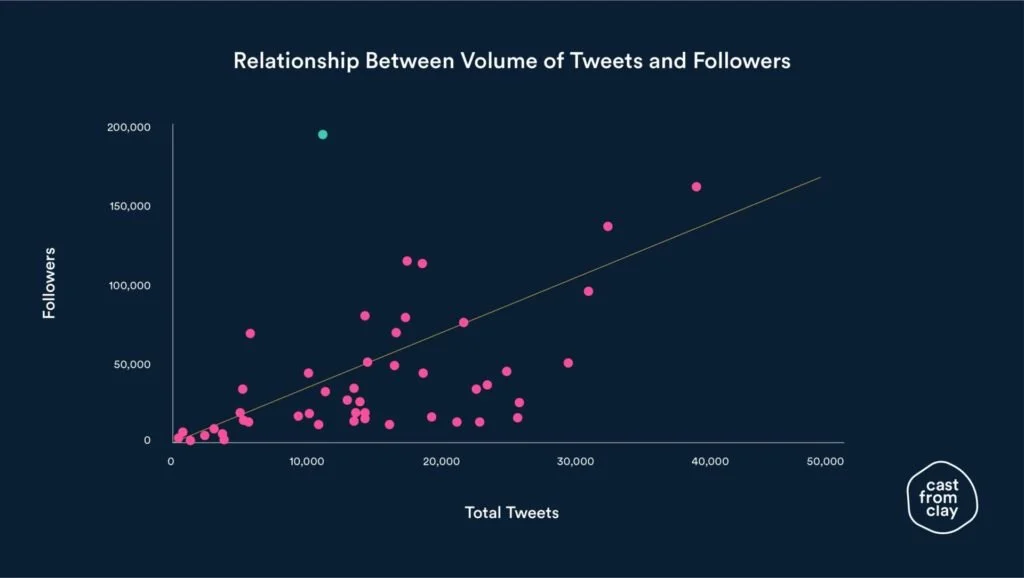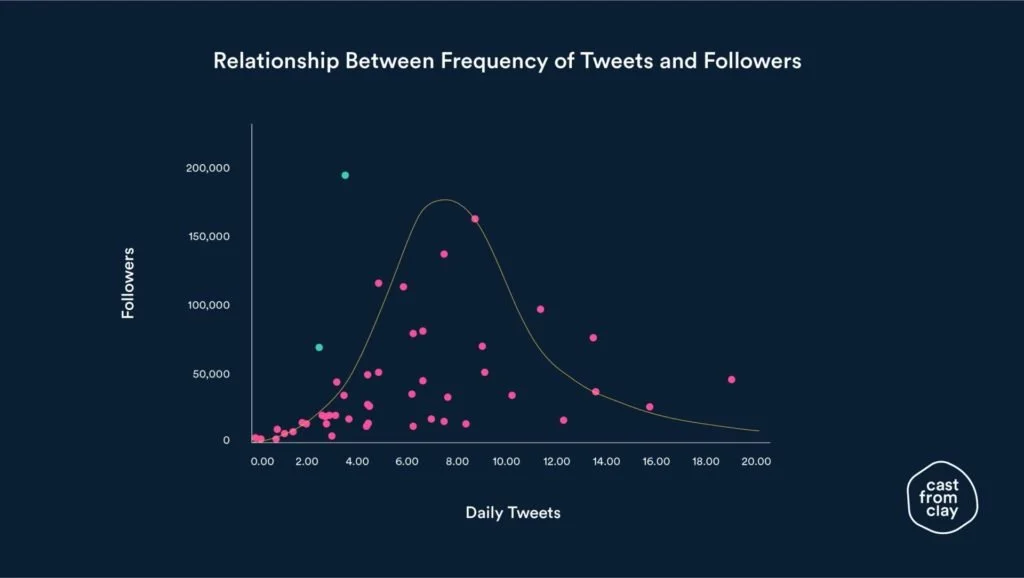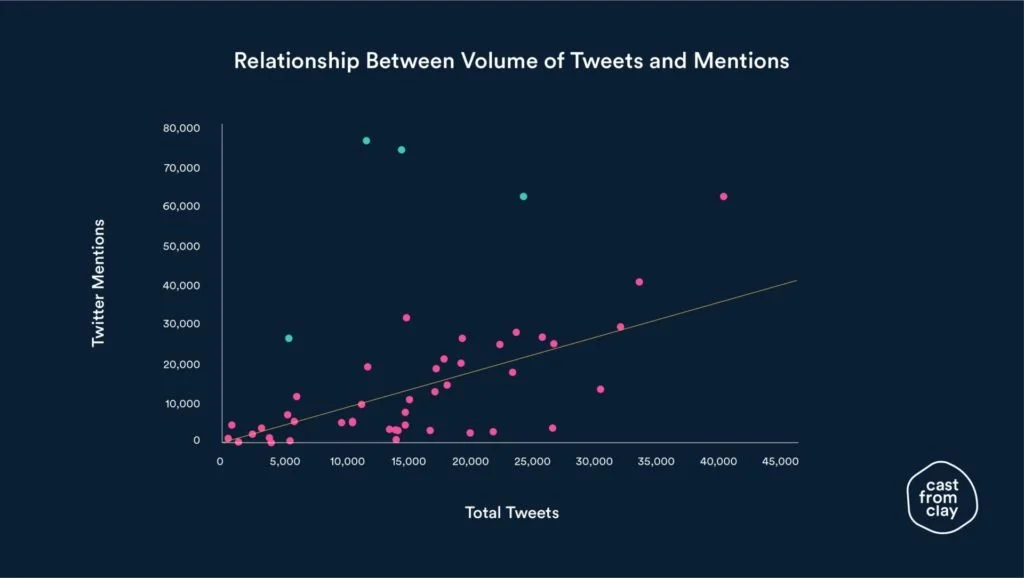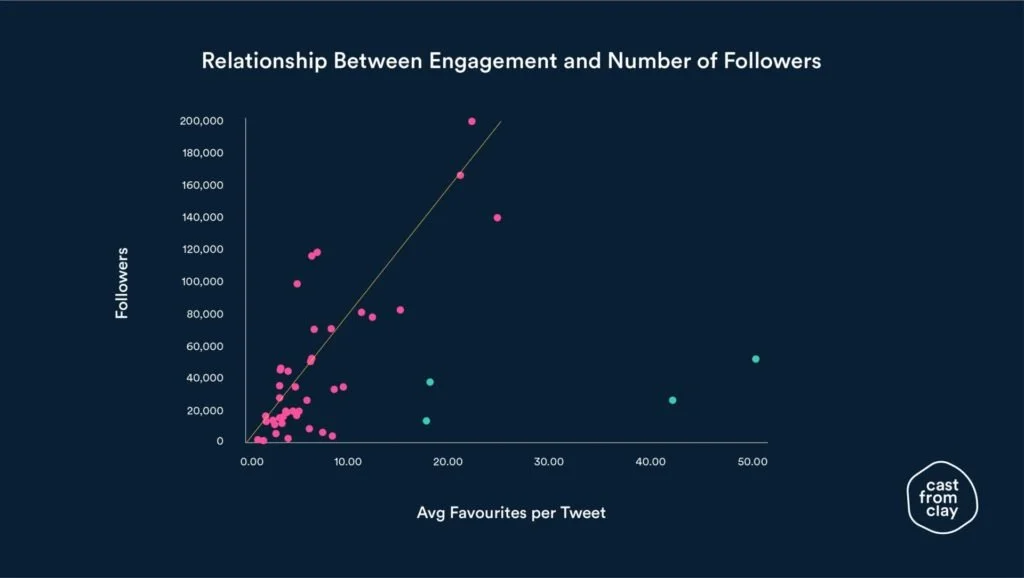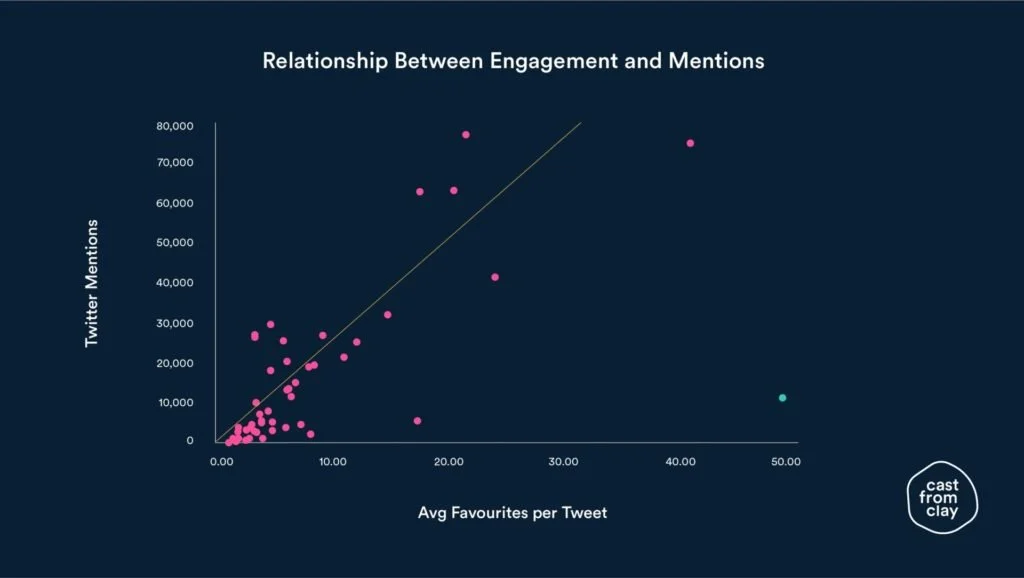Think tanks on Twitter: what the data tells us
This blog post was originally published on 7 July 2020 on the Cast From Clay website.
Twitter has been a favourite platform for policy experts for over a decade. It is the platform of choice for influencers to spread ideas, and connect with other influencers publicly. One question we are often asked is: what does best practice look like?
There are a number of received wisdoms in social media:
Post regularly and frequently.
Build visibility and reach.
Post quality content.
Build your follower base.
Engage rather than broadcast.
However, these have never been put to the test in the context of think tanks.
There is little data on what the relationship between these elements are. And it is hard to find any benchmark on what constitutes ‘regular’, ‘frequent’, ‘quality’, or any other indicator.
For example, is tweeting always a good thing? What is the relationship between tweeting and building your follower base? Does having a large following necessarily mean you are more relevant? Are engagements a cause or a consequence of having a large following?
In my last post on the Four Stages of Digital Maturity, I made the argument for analytics to inform strategy. So, we decided to do a little analysis of our own. We took 50 of the most high-profile think tanks in the UK – you can see a full list at the end – and we ran the numbers on their Twitter handles over a 12 month period. This is what we found.
Tweeting helps you build a community… broadly.
Tweeting too much may be a barrier to community-building.
Tweeting helps you stay relevant.
Followers create buzz, but buzz does not always attract followers.
Quality content does attract followers.
Engaging content drives mentions.
1. Tweeting helps you build a community… broadly
The graph below shows the relationship between the total number of tweets ever posted and the number of followers. We see a loose linear relationship between the two – broadly speaking, the more a Twitter channel has tweeted, the more followers it has.
© Cast From Clay 2020
However, the relationship is clearly a little more complex.
First, the relationship between volume and followers is clearer for those channels that are in the early stages of their development. Put simply, when you are launching a Twitter channel, it is important to post often to build up your visibility and your following.
Secondly, an obvious variable is the quality of the content posted. Posting a lot does not in itself guarantee followers – if it were, spam accounts and bots would have huge numbers of followers (they don’t). Conversely, posting one tweet a year does not build a community, no matter how good the tweet is.
Thirdly, Chatham House – the outlier above the line, in blue – suggests that reputation and/or offline profile matters. Being regularly mentioned in the media and by influencers won’t have hurt in terms of building their follower base.
Finally, another variable might be paid promotion. Paid can certainly boost followers – however it is impossible to infer from this dataset who has or who hasn’t made use of this tactic.
2. Tweeting too much may be a barrier to community-building
Another interesting factor comes in when mapping followers against the number of tweets a handle posts per day (total of original tweets, @replies and retweets). This relationship looks more like a bell curve.
The think tanks with the highest number of followers typically posted somewhere between 5 and 10 tweets a day; while those who tweeted most were not necessarily rewarded in terms of followers. This suggests there is a sweet spot. Typically, they had sustained that cadence over a number of years.
© Cast From Clay 2020
Not tweeting enough will limit your following, but it seems tweeting too often can also have a detrimental effect. Those think tanks who tweet most, often also find themselves some way below the line on the graph in the previous section.
Rather than posting a lot, the key is in posting regularly over a sustained period of time.
At the other end of the scale, Chatham House and RUSI (both in blue) show there can be exceptions to the rule. Posting only a few tweets a day does not in every case mean a low follower count. Content quality and paid promotion are potential variables in this regard.
3. Tweeting helps you stay relevant
The next graph maps the number of times each think tank’s handle was mentioned in the last 12 months against the number of historical tweets they have posted. The aim being to find out whether tweeting a lot makes you more relevant.
Broadly speaking, the answer is yes.
© Cast From Clay 2020
Once again, there are some notable exceptions.
Chatham House, the Institute for Fiscal Studies (IFS), the TaxPayers Alliance (TPA), and the Institute of Economic Affairs (IEA) – all in blue – were mentioned by third-party handles more often than their level of tweeting would predict.
All of these organisations have significant media profiles, which probably goes some way to explain their divergence. Research conducted by the IFS, often seen by left and right as an arbiter of sensible policy, is also regularly mentioned by politicians to validate their narratives.
However, the next graph shows there is another reason which almost certainly comes into play for the IEA and the TPA.
4. Followers create buzz, but buzz does not always attract followers
Mapping the number of Twitter mentions of each think tank over a 12-month period against their Twitter followers, we find a reasonably straightforward relationship.
© Cast From Clay 2020
What is the causal relationship is between the two?
It would be fair to assume that the more a think tank is discussed, the more followers it will attract; but it is equally true that the more followers it has, the easier it is to create a buzz. In many cases, it is likely these two factors will be mutually reinforcing.
However, the two outliers in the top left of the graph – the IEA and the TPA, both in blue – suggest an important caveat: negative buzz may boost your Twitter mentions, but it does not translate into followers.
In both instances, their tweets often elicited replies asking them to reveal their funding.
This might suggest the key driver is followers generating mentions, rather than mentions necessarily attracting followers. There is such a thing as bad publicity!
5. Quality content does attract followers
The graph below maps the extent to which an account’s tweets have been engaged with, against its number of followers.
(We looked at favourites here rather than retweets, because retweets are a form of mention – and as we saw in the previous graph, followers and mentions are linked. And to compare like with like, we looked at average number of favourites per tweet, as opposed to the total.)
Again, we found the relationship was broadly linear.
© Cast From Clay 2020
Once again, the question is: Does content quality – measured in engagements – drive follower numbers? Or is it simply that the more followers you have, the more likely your tweets will be engaged with?
Inevitably, there will be an element of mutual reinforcing. But the graph in the next section suggests that the key driver is this: good content generates followers, rather than the other way round.
The outliers are: the TPA, the Adam Smith Institute, the Bow Group, the IEA (all in blue), and the Bruges Group (off-chart). It may be relevant that they are all conservative, typically free-market think tanks.
Perhaps this constituency is currently smaller but more engaged. Or maybe their content is striking a chord (though we might also expect to see this convert into followers). The Adam Smith Institute has been experimenting, with some success, with meme formats.
For those handles closer to the top of the graph, the high level of engagement may also be explained by clever use of paid promotion. (Disclaimer: We don’t know that any of these accounts have used paid promotion.)
However, we suspect this may be to do with the fact that right-wing think tanks are typically more effective at leveraging their experts and spokespeople on Twitter, while left-wing think tanks tend to be more focused on the academic side. We don’t have space to explore this here – this will have to be the subject of a separate blog.
6. Engaging content drives mentions
The graph below maps the engagement with an account’s tweets against the number of times it has been mentioned over a 12-month period.
Again, we see a similar linear relationship.
© Cast From Clay 2020
While the relationship needed unpicking in the previous section, this one seems clearer. In terms of causation, it is more likely that good content encourages mentions, rather than the other way round. Mentions can drive engagement – but the discussion needs to be triggered in the first place by engaging content.
Once again, the Adam Smith Institute (in blue) and the Bruges Group (off-chart) are outliers.
There is much further exploration to be done. We’d like to update this to include US/international think tanks in the future. If you are interested in discussing how your think tank measured up, do get in touch!
In the meantime, here is our summary of five things the data tells us.
Key take-aways:
Regular tweets help build an online community – especially in the early days.
There is a sweet spot – somewhere between 5 and 10 tweets a day.
Tweeting broadly encourages mentions, and helps keep you relevant.
Positive mentions build your follower base – negative mentions don’t.
Quality content will drive both followers and mentions.
List of think tanks included in the study
The think tanks and policy organisations covered in this analysis were as follows:
Adam Smith Institute
The Bow Group
Bright Blue
The Bruges Group
Center for Global Development (CGD)
Centre for Cities
Centre for Economic and Policy Research (CEPR)
Centre for European Reform (CER)
Centre for London
Centre for Social Justice
Civitas
Chatham House
Cobden Centre
Demos
Education Foundation
Education Policy Institute (EPI)
Fabian Society
Foreign Policy Centre
Health Foundation
Henry Jackson Society
Institute for Fiscal Studies (IFS)
Institute for Free Trade
Institute for Government (IfG)
Institute for Public Policy Research (IPPR)
Institute for Strategic Dialogue
Institute of Economic Affairs (IEA)
International Institute for Strategic Studies (IISS)
Joseph Rowntree Foundation
The King’s Fund
Legatum Institute
LSE Ideas
Mutuo
National Institute of Economic and Social Research (NIESR)
New Economics Foundation (NEF)
Nuffield Trust
Onward
Overseas Development Institute (ODI)
Policy Exchange
Reform
Resolution Foundation
ResPublica
Royal Society of the Arts (RSA)
Royal United Services Institute (RUSI)
Social Market Foundation (SMF)
TaxPayers Alliance (TPA)
Theos
UK in a Changing Europe


